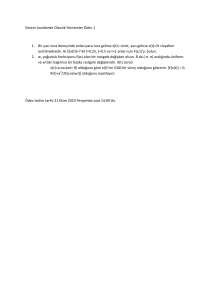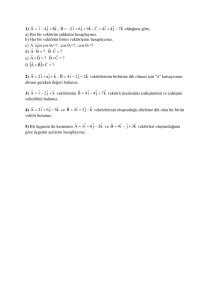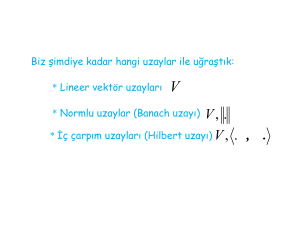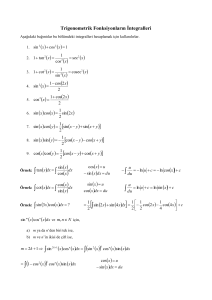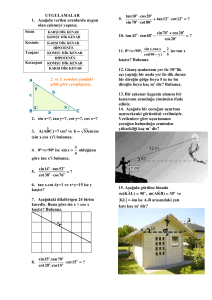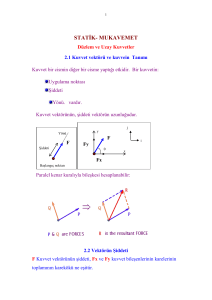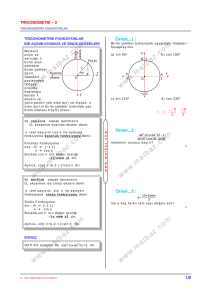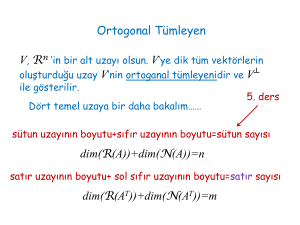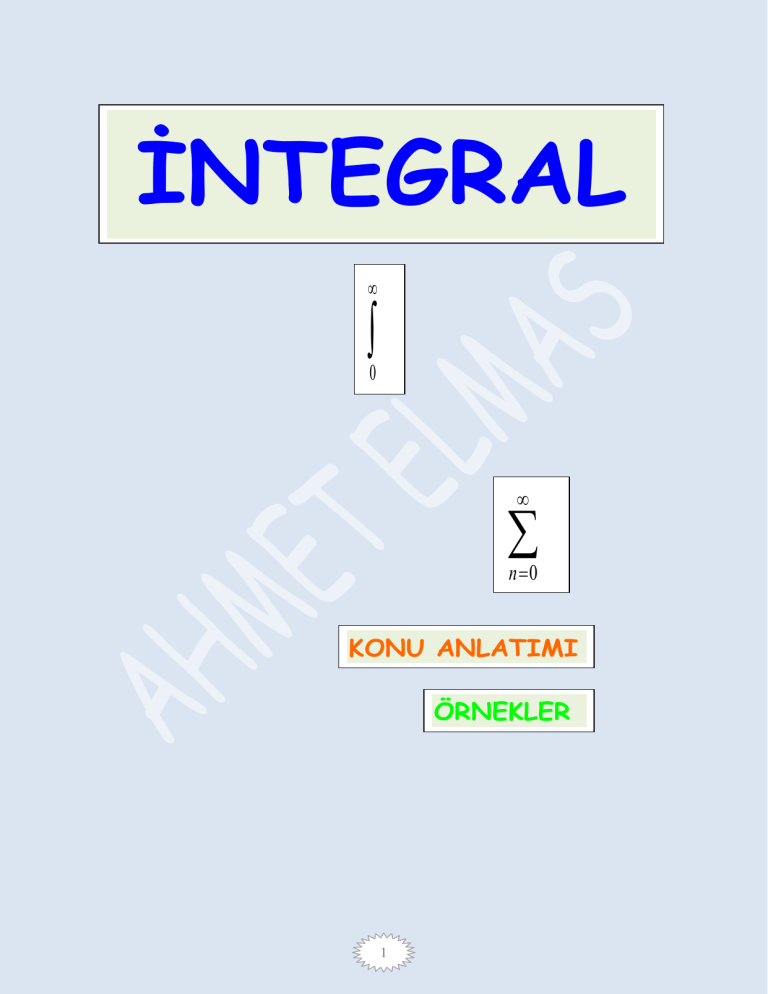
İNTEGRAL
0
n 0
KONU ANLATIMI
ÖRNEKLER
1
Ġntegral almak , ‘’türevi verilen bir
fonksiyonu bulmak’’tır.
ÖRNEK:
dy
f (x) , x (a, b)
dx
ÖRNEK:
( C , herhangi bir sabit.)
dx
1
x 2 dx 2 x C
x
4
6x 2
2
x2
(1 u)(1 u u
biçiminde gösterilir.
dF ( x) f ( x)dx F ( x) C
2
5
3
dx x 2 x C
x
ÖRNEK:
f ( x)dx F ( x) C
2
)du (1 u 3 )du
1
u u4 C
4
)
ÖRNEK:
ÖRNEK:
dy
3x 2 , dy 3x 2 dx
dx
y 3x 2 dx x 3 C
3
4
3
x dx x dx x 3 C
4
5x
koĢulunu sağlayan y = F(x)
fonksiyonuna f(x) in x ‘e göre
integrali denir.
d (x
1
3
ÖRNEK:
dF ( x)
f ( x)
dx
(
3
ÖRNEK:
dy
2 x için y nin x cinsinden ifadesi:
dx
(
3
2 2
x C
3
ÖRNEK:
fonksiyonu olarak verildiğini ve
y=F(x) in istendiğini varsayalım.
y=x2 + C dir.
1
x dx x 2 dx
v 1
v
1
dv dv dv
v
v
v
1
) x3 C )
u n 1
C
n 1
2
v v 2 v C
3
cos xdx sin x C
sin xdx cos x C
sec xdx tan x C
csc xdx cot x C
sec x tan xdx sec x C
csc x cot xdx csc x C
du u C
adu a du
(du dv) du dv
n
u du
1
v 2 dv v 2 dv
2
2
( n 1 )
ÖRNEK:
dx x C
ÖRNEK:
1
cos 2 xdx 2 sin 2 x C
ÖRNEK:
1
xdx 2 x
2
C
f (ax b)dx
2
F (ax b)
C
a
ÖRNEK:
ÖRNEK:
2
cos xdx
x
1
(1 cos 2 x)dx
2
d
(1 sin t ) 25 dt (1 sin x) 25
dx 1
1
1
x sin 4 x C
2
4
ÖRNEK:
x
d 20
t (1 t ) 20 dt x 20 (1 x) 20
dx 0
ÖRNEK:
tan xdx (1 tan x)dx dx
sec xdx tan xdx tan x x C
2
2
2
TEOREM:
f , [a,b] aralığında sürekli bir fonksiyon
ÖRNEK:
ve bir ilkeli F ise ;
x4 1
( x 1)( x 3 x 2 x 1)
dx
x 1 dx
x 1
x4 x3 x2
( x 3 x 2 x 1)dx
xC
4
3
2
b
f ( x)dx F (b) F (a)
a
ÖRNEK:
ÖRNEK:
sin x
cos 2 xdx sec x tan xdx sec x C
2
x4
2
x
dx
1
2
2
8
3
ÖRNEK:
dx
sin 2 x cos 2 x
sin 2 x cos 2 x sin 2 x cos 2 x dx
1
1 15
2 2
ÖRNEK:
5
5
( x 1)( x 1)dx ( x 1)dx
sec xdx csc xdx tan x cot x C
2
dır.
2
4
4
5
5
( x 1)dx
4
TEOREM:
f, [a,b] aralığında sürekli bir fonksiyon ve
x2
25
x
5 (8 4)
2
2
4
7
2
x
F(x) =
f (t ).dt
, x [a,b]
y=f(x) eğrisi , x=a , x=b doğruları ve
x ekseni ile sınırlı bölgenin alanı :
a
b
ise F fonksiyonu (a,b) aralığında türevi
alınabilir bir fonksiyon olup
F’(x) = f(x)
,
x (a,b)
A f ( x)dx dir.
a
dir.
ÖRNEK:
x
d
f (t )dt f ( x)
dx a
3
ÖRNEK:
ÖRNEK:
x3 1
( x 1)( x 2 x 1)
dx
dx
2 x 1 2
x 1
8
8
8
8
x3 x2
( x x 1)dx
x
3
2
2
2
2
512
8
32 8 ( 2 2) 204
3
3
UYARI:
Fonksiyon x=1 için TANIMSIZ (süreksiz)
olduğundan integral sınırları içinde olsaydı
integral alma iĢlemi yapılamazdı.
ÖRNEK:
ÖRNEK:
y=2x3-2x eğrisi ve x ekseni ile sınırlı
bölgenin alanı kaç birim karedir?
2x3-2x=2x(x-1)(x+1)=0
x1=-1 , x2=0 , x3=1
ÖRNEK:
0
1
A (2 x 3 2 x)dx | 2 x 3 2 x | dx
1
0
x4
x2
2
0
1
1
(2 x 3 2 x)dx
0
1
1
0 ( 1) ( 1) 0 1
2
2
b
a
f ( x)dx f ( x)dx
a
b
a
f ( x)dx 0
EK BİLGİ :
a
Parabol ve x ekseni ile sınırlı alan =
f , [a,b] de sürekli bir fonksiyon ve
2
2
32
Taban x Yükseklik= (2 (2)).4
3
3
3
c [a, b] için ;
b
c
b
a
a
c
f ( x)dx f ( x)dx f ( x)dx
4
ÖRNEK:
2
1 x .dx ?
y=f(x) ve y=g(x) eğrileri ile
sınırlı bölgenin alanı ;
0
1-x = 0 için x=1
2
b
1
2
1 x .dx 1 x .dx 1 x .dx
0
0
1
f ( x) g ( x) .dx
a
1
2
(1 x).dx ( x 1).dx
0
1
2 1
x
x
2
1
0
ÖRNEK:
y = x3 – x2 – 2x eğrisi ve x ekseni ile sınırlı
bölgenin alanı kaç br2 dir?
2
x2
x
2
1
1
1
0 2 2 ( 1) 1
2
2
ÖRNEK:
y = 2-x doğrusu ve y = x2 parabolü ile
sınırlı bölgenin alanı kaç br2 dir ?
x 3 x 2 2 x x( x 1)( x 2) 0
x1=-1 ,
x2=0
, x3=2
2
y = 2-x doğrusu ve y = x parabolü
2-x = x2 , x2+x-2=0 , x1=-2 ve x2=1
noktalarında kesiĢirler.
2
A
x
3
x 2 2 x .dx
1
0
2 x x .dx (2 x x
1
A=
2
x2 x3
2x
2
3
3
2
).dx
2
1
2
2
2
( x x 2 x).dx ( x 3 x 2 2 x).dx
1
x4 x3
x2
4
3
1
2
0
0
2
x4 x3
(
x2 )
4
3
1
0
8
1 1
37
0 1 4 4
3
4 3
12
1 1
8 9
2 4 2
2 3
3 2
5
ÖRNEK:
y = x2 – 1 ve y = 1 – x2 eğrileri ile
sınırlı bölgenin alanı kaç br2 dir?
ORTALAMA DEĞER TEOREMĠ:
f , [a,b] de sürekli bir fonksiyon iken ;
b
f ( x)dx (b a) f (c)
a
eĢitliğini sağlayan bir c [a,b] vardır.
ÖRNEK:
y = f(x) = x2 + 1 fonksiyonu için ;
[-2,1] aralığında ortalama değer teoremine
uygun c değerini bulunuz ?
x 2 1 1 x 2 2x 2 2 0
2( x 1)( x 1) 0 x1 1 ve x 2 1
A
(x
1
1
x3
(
x
1
).
dx
x
3
2
2
1
2
2
1) (1 x 2 ) .dx
1
1
2x3
(2 2 x ).dx 2 x
3
1
1
2
1
8
3
1
8
1 2 6
3
3
1
(x
1).dx (1 (2)) f (c)
2
ÖRNEK:
y=|x| ve y=2-x2
eğrileri ile
sınırlı bölgenin alanı kaç br2dir?
|x|=2-x2
x < 0 için ;
x 0 için ;
2
3 f (c ) 6 f (c ) 2
x2 1 2 x2 1
x1 = -1
, x2 = 1
-x-2+x2=0 , x1=-1
x-2+x2=0 , x2=1
1
A
2 x
2
x .dx
UYARI:
1
0
Dikdörtgen dıĢında kalan taralı alanın ,
Dikdörtgen içinde kalan taranmamıĢ alana
eĢitliğine dikkat ediniz.
1
(2 x 2 x)dx (2 x 2 x)dx
1
0
3
2 0
x
x
2x
3
2
x3 x2
2x
3
2
1
1
0
7 7 7
6 6 3
6
ÖRNEK:
y x
ve
y x 2 eğrileri ile
sınırlı bölgenin alanı kaç br2 dir ?
b
A [ f ( y ) g ( y )]dy
a
ÖRNEK:
x x 2 x1 0 , x2 1
x y 2 ve x
1
A ( x x 2 ).dx
1 2
y 2 eğrileri ile
2
sınırlı bölgenin alanı kaç br2 dir?
0
1
3
2
1
x 2 x3
3
3
ÖRNEK:
y sin x ve
x
4
, x
0
2 1 1
3 3 3
y cos x eğrilerinin
5
aralığında sınırladığı
4
y2
2
bölgenin alanı kaç br dir?
1 2
y 2 y1 2 ve y 2 2
2
1
1
A y 2 2 y 2 .dy 2 y 2
2
2
2
2
2
1
2y y3
6
2
2
4
2
4
4 16
4
3
3 3
UYARI:
5
4
A (sin x cos x).dx
4
5
4
a
b
0
0
A1 f ( x).dx ve A2 f 1 ( y ).dy
cos x sin x 2 2
4
7
ÖRNEK :
y x 3 ve
y3 x
eğrileri ile
sınırlı bölgenin alanı kaç br2 dir?
f , bir çift fonksiyon ise :
a
a
a
0
f ( x).dx A A 2 A 2 f ( x).dx
x3 3 x x9 x 0
x1 1 , x2 0 , x3 1
x
0
1
3
1
3 x .dx
4 0
a
f ( x).dx A A 0
dır.
a
3
x x 3 .dx
0
x4 3 3
x
4 4
f , bir tek fonksiyon ise :
4
3
x4
x3
4
4
1
1
0
1 1
1
2 2
ÖRNEK :
ÖRNEK :
4 2
4
sin x
1dx değeri kaçtır?
4
1 x
2
f ( x)
sin x
tek fonksiyon olduğundan
1 x4
y2+2y=4-y2
4 2
4
sin x
.dx 0 dır.
1 x4
2
4 2
4
y1=-2 , y2=1
1
A [(4 y 2 ) ( y 2 2 y )].dy
2
4 2
sin x
1dx 0 dx 8 2
4
1 x
2
4 2
1
2y3
(4 2 y 2 y ).dy 4 y y
3
2
2
4 1
8
2
16
8 4 9
3
3
1
2
2
ÖRNEK :
n N için :
x .dx ?
2
1
n çift iken ;
1
2
n
1 x dx n 1
1 x 0 x 1
0 x 1 x 0
n tek iken ;
1 x 2 x 1 olduğundan ;
1
x
0
1
1
1
2
0
1
dx 0 dır.
1
x .dx 1.dx 0.dx 1.dx
2
n
x 1 0 x 1
0
2
0 1 2 1 0
r pozitif rasyonel sayıları için :
1
1
x dx x
r
0
1
r
dx 1
0
ÖRNEK :
f (x)
6 ;
-2 < x < 1 için
-4 ;
1 < x < 3 için
5 ;
b
xf
3 < x < 8 için
''
( x).dx bf ' (b) af ' (a) f (a) f (b)
a
8
f ( x).dx =?
2
8
1
3
8
1
3
dx
1 x2
arcsin x C
( |x| < 1 )
f ( x).dx 6.dx 4.dx 5.dx
2
2
6 x 2 4 x 1 5 x 3
1
3
8
6 (12) (12 4) 40 15
35
9
dx
a2 x2
arcsin
x
C (a >0 , |x|<a)
a
ÖRNEK :
2
3
dx
4 9x 2
0
dx
ln x C
x
?
dx
2
3
dx
4 9x 2
0
1
3
2
3
0
4
x2
9
0
( a 0 )
dx
4
9( x 2 )
9
xa
x b dx x (a b) ln x b C
2
dx
1
ax b a ln ax b C
2
3
1
3x 3
arcsin
3
2 0
ÖRNEK :
1
1
1
arcsin
arcsin 0
3
2
3 4 12
dx
1
5x 7 5 ln 5x 7 C
ÖRNEK :
3
2( x )
2x 3
2 dx
6 x 1dx
1
6( x )
6
3
x
1
2 dx 1 x 3 1 ln x 1 C
1
3
3 2 6
6
x
6
1
5
1
x ln x C
3
9
6
dx
x 2 1 arctan x C
x
2
dx
1
x
arctan C ( a 0 )
2
a
a
a
ÖRNEK :
y
1
1 2
ve y x eğrileri ile sınırlı
2
x 1
2
bölgenin alanı kaç br2 dir?
1
1
x 2 x1=-1 , x2=1
2
x 1 2
1
1
1
1
A 2
x 2 dx 2 2
x 2 dx
2
2
1 x 1
0 x 1
1
f ' ( x)
dx ln f ( x) C
f ( x)
1
1
1
1
2 arctan x x 3
6 0 2 3
ÖRNEK :
x
2
2x 3
dx ln x 2 3x 2 C
3x 2
ÖRNEK :
sin x
(cos x) '
tan x.dx cos xdx cos x dx
ln cos x C ln sec x C
10
tan x.dx ln sec x C
dx
1
cot x.dx ln sin x C
xa
( x a)( x b) b a ln x b C
ÖRNEK :
0
(a b)
dx
1
xa
x 2 a 2 2a ln x a C
y
2
3
(a 0)
dy
dy
( y 1)( y 4)
3y 4
1
y 1
ln
4 (1) y 4
0
3
1 1 1
ln ln 4
5 4 5
1
4
ln 16 ln 2
5
5
ÖRNEK :
dx
dx
( x 2)( x 3)
x6
1
x2
1 x2
ln
C ln
C
3 (2) x 3
5 x3
x
e
2
x
dx e x C
ÖRNEK :
e3x 1
(e x 1)(e 2 x e x 1)
.
dx
dx
ex 1
ex 1
1
(e 2 x e x 1).dx e 2 x e x x C
2
ÖRNEK :
dx
dx
2
9
(2 x) 2 3 2
4x
1
2x 3
1 2x 3
ln
C ln
C
2(2)(3) 2 x 3
12 2 x 3
x
a dx
ÖRNEK :
ax
C
ln a
4
4
dt
1
2 8 5t 5 ln 8 5t 2
1
1
1 2
1
ln 12 ln 2 ln ln 6
5
5
5 12
5
ÖRNEK :
1
10 x
10 10 1
99
10
dx
1
ln 10 1
ln 10
10. ln 10
1
x
ÖRNEK :
ÖRNEK :
cos x
cot x.dx sin x .dx ln sin x C
1
1
u u
u
4 e du (4e) du
0
11
0
u 1
(4e)
ln 4e
0
4e 1
ln 4 1
ÖRNEK :
1
(3
1
0
0
x
3 x ).dx 3 x dx 3 x dx
x
0
ÖRNEK :
1
1
u 2 3x du 3.dx
1
x (u 2)
3
1
1
3 1
3
ln 3
ln 3
x 1
3
3
ln 3 0
ln 3
x
0
2 3x dx
8
3 ln 3
x
2 3x dx
3
ÖRNEK :
3
1
1
(u 2 2u 2 ).du
9
5
3
2 2 4 2
u u C
45
27
2
4
(2 3x) 2 2 3x (2 3x) 2 3x C
45
27
f u( x).u' ( x).dx f (u).du
sin
1
(u 2) u .du
9
x. cos x.dx
u sin x du cos x.dx
ÖRNEK :
u4
sin
x
.
cos
x
.
dx
u
du
C
4
1
sin 4 x C
4
3
sec x.dx
3
sec x tan x
sec x.dx sec x. sec x tan x .dx
ÖRNEK :
sin
3
x.dx
sec x. tan x sec 2 x
.dx
sec x tan x
u sec x tan x du sec x. tan x sec 2 x
sin 3 x sin 2 x. sin x
cos 2 x sin 2 x 1 sin 2 x 1 cos 2 x
du
ln u C
u
ln sec x tan x C
sin x.dx sin x.sin x.dx
(1 cos x). sin x.dx
sin x.dx cos x. sin x.dx
3
2
2
2
sec x.dx ln sec x tan x C
u cos x du sin x.dx
csc x.dx ln csc x cot x C
cos x u 2 du
1
cos x u 3 C
3
1
cos x cos 3 x C
3
b
u (b )
a
u(a)
f u( x).u' ( x).dx f (u).du
12
ÖRNEK :
u.dv uv v.du
e
ln x
1 x .dx
ÖRNEK :
x.sin x.dx
dx
x
u ln x du
x 1 ln 1 0
x e ln e 1
e
u x du dx
dv sin x.dx v cos x.dx
1
ln x
1 2
1 x .dx 0 u.du 2 u
1
0
x.sin x.dx x. cos x cos x.dx
1
2
x. cos x sin x C
ÖRNEK :
ÖRNEK :
dx
ln x.dx
x (1 x )
u x du
dx
x (1 x )
dx
u ln x du
2 x
dv dx v x
2
dx
x
ln x.dx x. ln x dx
du
1 u
x. ln x x C
2 ln 1 u C 2 ln 1 x C
UYARI :
Ġntegrali alınacak ifade de ,
hangi fonksiyona ‘’u’’ , hangisine de ‘’dv’’
denileceğini kolaylaĢtıran bir yol :
ÖRNEK :
3
1
ds
s (1 s)
u s du
s 1 u 1
‘’LAPTÜ’’ kelimesinde ;
L ; logaritma
A ; arcsin, arccos gibi ters trigonometrik
fonksiyonlar
P ; polinom fonksiyon
T ; trigonometrik fonksiyon
Ü ; üstel fonksiyon
ds
2 s
s 3u 3
3
1
ds
s (1 s )
3
du
2
1 1 u
2
olmak üzere iki değiĢik fonksiyondan önce
gelen fonksiyon ‘’u’’ , diğer kısım ‘’dv’’ ile
gösterilir.
2 arctan u 1 2 arctan 3 arctan 1
3
2
3 4 6
13
ÖRNEK :
ÖRNEK :
x. ln x.dx
sec x.dx sec x.sec
dx
x
x2
dv x.dx v
2
u sec x du sec x. tan x.dx
3
u ln x du
2
x.dx
dv sec 2 x.dx v tan x
sec x. tan x tan 2 x. sec x.dx
tan 2 x sec 2 x 1
sec x. tan x (sec 2 x 1) sec x.dx
x2
1
x
.
ln
x
.
dx
ln x x.dx
2
2
1
1
x 2 ln x x 2 C
2
4
sec x. tan x sec 3 x.dx sec x.dx
2 sec 3 x.dx sec x. tan x sec x.dx
ÖRNEK :
sec
1
arctan x.dx
3
x.dx
1
1
sec x. tan x ln sec x tan x C
2
2
0
u arctan x du
dv dx v x
dx
1 x2
1
ÖRNEK :
e
ax
cos bx.dx
u cos bx du b sin bx.dx
1
x
0 arctan x.dx x. arctan x 0 0 1 x 2
1
dv e ax dx v
1
1
arctan 1 ln(1 x 2 )
0
2
1
ln 2
4 2
ax
e cos bx.dx
ÖRNEK :
x e
2
x
2
e ax
e ax
cos bx
(b sin bx.dx)
a
a
e ax cos bx b ax
e sin bx.dx
a
a
u sin bx du b cos bx.dx
dx
dv e ax dx v
u x 2 du 2 x.dx
dv e x dx v e x
x e
x
e ax
a
dx x 2 e x 2 x.e x dx
e ax cos bx be ax sin bx b 2 ax
a e cos bx.dx
a
a2
a
2
b ax
cos bx b sin bx
1 2 e cos bx.dx e ax
a2
a
a
dv e x dx v e x
e ax cos bx b e ax sin bx b ax
e cos bx.dx
a
a
a
a
u x du dx
x 2 e x 2 xe x e x dx
e ax
a
x 2 e x 2 xe x 2e x C
14
e
e
cos bx.dx e ax
ax
sin bx.dx e ax
ax
a cos bx b sin bx
C
a2 b2
ÖRNEK :
cos
a sin bx b cos bx
C
a2 b2
cos
cos
5
1
4
x.dx cos 4 x. sin x cos 3 x.dx
5
5
5
1
2
x.dx cos 2 x. sin x cos x.dx
3
3
3
1
4
8
x.dx cos 4 x. sin x cos 2 x. sin x sin x C
5
15
15
ÖRNEK :
sin
n
( n=2,3,… )
x.dx
x
u sin n1 x du (n 1) sin n2 x. cos x.dx
dv sin x.dx v cos x
sin
x.dx sin n1 x. cos x (n 1) sin n2 x. cos 2 x.dx
n
n
e x dx x n e x n x n1e x dx
ÖRNEK :
cos x 1 sin x
x e dx x e
sin n1 x. cos x (n 1) sin n2 x.dx (n 1) sin n x.dx
xe
n sin n x.dx sin n1 x. cos x (n 1) sin n2 x.dx
x e dx x e
2
2
2
2
x
x
2
x
2 xe x dx
dx xe x e x dx
x
2
x
2 xe x 2e x C
sin
n
cos
n
1
n 1
x.dx sin n1 x. cos x
sin n2 x.dx
n
n
x
1
n 1
x.dx cos n1 x. sin x
cos n2 x.dx
n
n
x
( n=2,3,….. )
ÖRNEK :
sin
2
4
n
sin x.dx x n cos x n x n1 cos x.dx
cos x.dx x n sin x n x n1 sin x.dx
ÖRNEK :
1 3
3
2
sin x.dx 4 sin x. cos x 4 sin x.dx
x
4
sin
n
2
sin x.dx x 2 cos x 2 x cos x.dx
x cos x.dx x sin x sin x.dx
1
1
x.dx sin x. cos x dx
2
2
x
1
3
3
x.dx sin 3 x. cos x sin x. cos x x C
4
8
8
15
2
sin x.dx x 2 cos x 2 x sin x 2 cos x C
𝑠𝑖𝑛𝑚 𝑥. 𝑐𝑜𝑠 𝑛 𝑥 𝑑𝑥
ÖRNEK:
ġeklindeki integral iĢlemlerinde:
𝑠𝑖𝑛 5 𝑥
𝑐𝑜𝑠𝑥
n tek ise:
sin
m
yazılır.
1−𝑐𝑜𝑠 2 𝑥
=
x. cos n x.dx sin m x. cos n1 x. cos x.dx
𝑐𝑜𝑠𝑥
𝑠𝑖𝑛 5 𝑥
𝑐𝑜𝑠𝑥
=−
m tek ise:
sin x. cos x.dx sin
m
n
m1
=−
n
𝑐𝑜𝑠𝑥
𝑠𝑖𝑛𝑥𝑑𝑥
dersek
𝑢 4 −2𝑢 2 +1
𝑈1 2
2
𝑑𝑢 = − − 𝑠𝑖𝑛𝑥 𝑑𝑥 olur.
1−𝑢 2
𝑑𝑥 = −
𝑢7
𝑠𝑖𝑛𝑥 𝑑𝑥
𝑢
2
𝑑𝑢
𝑑𝑢
− 2𝑢3
2
+ 𝑢−1
2
𝑑𝑢
x. sin x. cos x.dx
= −29𝑢9
yazılır.
sin2x = 1-cos2x
2
𝑢 = 𝑐𝑜𝑠𝑥
cos2x = 1-sin2x kullanılır.
𝑠𝑖𝑛 4 𝑥
𝑑𝑥 =
2
+ 45𝑢5
= −29 𝑐𝑜𝑠𝑥
kullanılır.
9 2
2
− 2𝑢1
+ 45 𝑐𝑜𝑠𝑥
2
+𝐶
5 2
− 2 𝑐𝑜𝑠𝑥
1 2
+𝐶
m ve n çift ise:
1
1
(1-cos 2x) , cos2x = (1+cos 2x)
2
2
1
sin x.cos x =
sin 2x
kullanılır.
2
sin2x =
ÖRNEK:
𝑠𝑖𝑛2 𝑥. 𝑐𝑜𝑠 4 𝑥 𝑑𝑥
ÖRNEK:
𝑠𝑖𝑛4 𝑥. 𝑐𝑜𝑠 7 𝑥 𝑑𝑥
𝑠𝑖𝑛4 𝑥. 𝑐𝑜𝑠 6 𝑥. 𝑐𝑜𝑠𝑥 𝑑𝑥
=
𝑠𝑖𝑛4 𝑥 1 − 𝑠𝑖𝑛2 𝑥 3 𝑐𝑜𝑠𝑥 𝑑𝑥
𝑠𝑖𝑛 𝑥. 𝑐𝑜𝑠 𝑥 𝑑𝑥 =
4
7
1 − 𝑐𝑜𝑠2𝑥 1 + 𝑐𝑜𝑠2𝑥
= 18
1 + 𝑐𝑜𝑠2𝑥 − 𝑐𝑜𝑠 2 2𝑥 − 𝑐𝑜𝑠 3 2𝑥 𝑑𝑥
𝑑𝑥
1
=18𝑥 + 16
𝑠𝑖𝑛2𝑥 − 18 𝑐𝑜𝑠 2 2𝑥 𝑑𝑥 − 18 𝑐𝑜𝑠 3 2𝑥 𝑑𝑥
=
𝑢 = 𝑠𝑖𝑛𝑥 dersek
2
= 18
𝑐𝑜𝑠 2 2𝑥 𝑑𝑥 = 12
𝑐𝑜𝑠 3 2𝑥 𝑑𝑥 =
𝑑𝑢 = 𝑐𝑜𝑠𝑥 𝑑𝑥 olur.
=
𝑢
4
1−𝑢
2 3
1 + 𝑐𝑜𝑠4𝑥 𝑑𝑥 = 12𝑥 + 18𝑠𝑖𝑛4𝑥
𝑐𝑜𝑠 2 2𝑥. 𝑐𝑜𝑠2𝑥 𝑑𝑥
1 − 𝑠𝑖𝑛2 2𝑥 𝑐𝑜𝑠2𝑥 𝑑𝑥
𝑑𝑢
𝑢 = 𝑠𝑖𝑛2𝑥 dersek 𝑑𝑢 = 2𝑐𝑜𝑠2𝑥 olur.
4
2
4
6
=
𝑢
=
𝑢4 − 3𝑢6 + 3𝑢8 − 𝑢10 𝑑𝑢
1
1 − 3𝑢 + 3𝑢 − 𝑢 𝑑𝑢
3
1
= 5𝑢5 − 7𝑢7 + 3𝑢9 −
𝑐𝑜𝑠 3 2𝑥 𝑑𝑥 = 12
1 − 𝑢2 𝑑𝑢 = 12𝑢 − 16𝑢3
= 12𝑠𝑖𝑛2𝑥 − 16𝑠𝑖𝑛3 2𝑥
değerleri yerlerine yazıldığında:
1 11
𝑢 +𝐶
11
𝑠𝑖𝑛2 𝑥. 𝑐𝑜𝑠 4 𝑥 𝑑𝑥
1
= 15𝑠𝑖𝑛5 𝑥 − 37𝑠𝑖𝑛7 𝑥 + 13𝑠𝑖𝑛9 𝑥 − 11
𝑠𝑖𝑛11 𝑥 + 𝐶
1
1
1
= 16
𝑥 − 64
𝑠𝑖𝑛4𝑥 + 48
𝑠𝑖𝑛3 2𝑥 + 𝐶
16
ÖRNEK:
ÖRNEK:
𝑐𝑜𝑡 3 𝑥𝑐𝑠𝑐 3 𝑥 𝑑𝑥 =
𝑡𝑎𝑛𝑥 𝑠𝑒𝑐 4 𝑥 𝑑𝑥 = ( 𝑡𝑎𝑛𝑥 𝑠𝑒𝑐 2 𝑥)𝑠𝑒𝑐 2 𝑥 𝑑𝑥
=
𝑐𝑜𝑡 2 𝑥 = 𝑐𝑠𝑐 2 𝑥 − 1 eĢitliği kulanıldığında;
𝑡𝑎𝑛𝑥 (𝑡𝑎𝑛2 𝑥 + 1)𝑠𝑒𝑐 2 𝑥 𝑑𝑥
𝑢 = 𝑡𝑎𝑛𝑥 dersek
𝑡𝑎𝑛𝑥 𝑠𝑒𝑐 4 𝑥 𝑑𝑥 =
= (𝑢5
2
= 27 𝑡𝑎𝑛𝑥
𝑑𝑢 = 𝑠𝑒𝑐 2 𝑥 𝑑𝑥
𝑢 𝑢2 + 1 𝑑𝑢
+ 𝑢1 2 )𝑑𝑢 = 𝑢7
2
7 2
+𝐶
2
7
3 2
+ 23 𝑡𝑎𝑛𝑥
+ 𝑢3
2
3
2
olur.
+𝐶
5
𝑡𝑎𝑛 𝑥𝑠𝑒𝑐 𝑥 𝑑𝑥 =
2
𝑡𝑎𝑛 𝑥𝑠𝑒𝑐 𝑥 𝑠𝑒𝑐𝑥𝑡𝑎𝑛𝑥 𝑑𝑥
𝑠𝑒𝑐 2 𝑥 − 1 𝑠𝑒𝑐 4 𝑥 𝑠𝑒𝑐𝑥𝑡𝑎𝑛𝑥 𝑑𝑥
=
𝑠𝑒𝑐 6 𝑥 − 𝑠𝑒𝑐 4 𝑥 𝑠𝑒𝑐𝑥𝑡𝑎𝑛𝑥 𝑑𝑥
𝑢 = 𝑠𝑒𝑐𝑥 dersek
𝑡𝑎𝑛3 𝑥𝑠𝑒𝑐 5 𝑥 𝑑𝑥 =
𝑐𝑠𝑐 2 𝑥 − 1 𝑐𝑠𝑐 2 𝑥𝑑 𝑐𝑠𝑐𝑥
=−
𝑐𝑠𝑐 4 𝑥 − 𝑐𝑠𝑐 2 𝑥 𝑑 𝑐𝑠𝑐𝑥
𝑠𝑖𝑛𝑎𝑥𝑐𝑜𝑠𝑏𝑥 𝑑𝑥
𝑐𝑜𝑠𝑎𝑥𝑐𝑜𝑠𝑏𝑥 𝑑𝑥
𝑠𝑖𝑛𝑎𝑥𝑠𝑖𝑛𝑏𝑥 𝑑𝑥
ġeklindeki integral iĢlemlerinde;
4
=
=−
= −15𝑐𝑠𝑐 5 𝑥 + 13𝑐𝑠𝑐 3 𝑥 + 𝐶
ÖRNEK:
3
𝑐𝑜𝑡 2 𝑥𝑐𝑠𝑐 2 𝑥 𝑐𝑠𝑐𝑥𝑐𝑜𝑡𝑥 𝑑𝑥
𝑠𝑖𝑛𝑎𝑥𝑐𝑜𝑠𝑏𝑥 = 12 𝑠𝑖𝑛 𝑎 + 𝑏 𝑥 + 𝑠𝑖𝑛 𝑎 − 𝑏 𝑥
𝑐𝑜𝑠𝑎𝑥𝑐𝑜𝑠𝑏𝑥 = 12 𝑐𝑜𝑠 𝑎 + 𝑏 𝑥 + 𝑐𝑜𝑠 𝑎 − 𝑏 𝑥
𝑠𝑖𝑛𝑎𝑥𝑠𝑖𝑛𝑏𝑥 = 12 𝑐𝑜𝑠 𝑎 − 𝑏 𝑥 − 𝑐𝑜𝑠 𝑎 + 𝑏 𝑥
TersdönüĢüm formülleri kullanılır.
𝑑𝑢 = 𝑠𝑒𝑐𝑥𝑡𝑎𝑛𝑥 𝑑𝑥 olur.
𝑢6 − 𝑢 4 𝑑𝑢
= 17𝑢7 − 15𝑢5 + 𝐶
ÖRNEK:
= 17𝑠𝑒𝑐 7 𝑥 − 15𝑠𝑒𝑐 5 𝑥 + 𝐶
𝑠𝑖𝑛2𝑥𝑐𝑜𝑠5𝑥 𝑑𝑥 = 12 𝑠𝑖𝑛7𝑥 𝑑𝑥 − 12 𝑠𝑖𝑛3𝑥 𝑑𝑥
ÖRNEK:
𝑡𝑎𝑛2 𝑥𝑠𝑒𝑐 3 𝑥 𝑑𝑥 =
=
1
= −14
𝑐𝑜𝑠7𝑥 + 16𝑐𝑜𝑠3𝑥 + 𝐶
𝑠𝑒𝑐 2 𝑥 − 1 𝑠𝑒𝑐 3 𝑥 𝑑𝑥
𝑠𝑒𝑐 5 𝑥 𝑑𝑥 − 𝑠𝑒𝑐 3 𝑥 𝑑𝑥
ÖRNEK:
𝑢 = 𝑠𝑒𝑐 3 𝑥 ve 𝑑𝑣 = 𝑠𝑒𝑐 2 𝑥 𝑑𝑥 dersek
𝑑𝑢 = 3𝑠𝑒𝑐 3 𝑥𝑡𝑎𝑛𝑥 𝑑𝑥 ve 𝑣 = 𝑡𝑎𝑛𝑥
olacağından;
𝑢𝑑𝑣 = 𝑢𝑣 − 𝑣𝑑𝑢 kısmi integralinden
𝑐𝑜𝑠4𝑥𝑐𝑜𝑠5𝑥 𝑑𝑥 = 12 𝑐𝑜𝑠9𝑥 𝑑𝑥 + 12 𝑐𝑜𝑠𝑥 𝑑𝑥
1
= 18
𝑠𝑖𝑛9𝑥 + 12𝑠𝑖𝑛𝑥 + 𝐶
𝑠𝑒𝑐 5 𝑥 𝑑𝑥 = 𝑠𝑒𝑐 3 𝑥𝑠𝑒𝑐 2 𝑥 𝑑𝑥
= 𝑠𝑒𝑐 3 𝑥𝑡𝑎𝑛𝑥 − 3 𝑡𝑎𝑛2 𝑥𝑠𝑒𝑐 3 𝑥 𝑑𝑥 olur.
Yerine yazıldığında;
𝑡𝑎𝑛2 𝑥𝑠𝑒𝑐 3 𝑥 𝑑𝑥 = 14𝑠𝑒𝑐 3 𝑥𝑡𝑎𝑛𝑥 − 14 𝑠𝑒𝑐 3 𝑥 𝑑𝑥
𝑠𝑒𝑐 3 𝑥 𝑑𝑥 = 12 𝑠𝑒𝑐𝑥𝑡𝑎𝑛𝑥 + 12𝑙𝑛 𝑠𝑒𝑐𝑥 + 𝑡𝑎𝑛𝑥 + 𝐶
ÖRNEK:
𝑠𝑖𝑛3𝑥𝑠𝑖𝑛6𝑥 𝑑𝑥 = 12 𝑐𝑜𝑠3𝑥 𝑑𝑥 − 12 𝑐𝑜𝑠9𝑥 𝑑𝑥
1
= 16𝑠𝑖𝑛3𝑥 − 18
𝑠𝑖𝑛9𝑥 + 𝐶
𝑡𝑎𝑛2 𝑥𝑠𝑒𝑐 3 𝑥 𝑑𝑥
= 14𝑠𝑒𝑐 3 𝑥𝑡𝑎𝑛𝑥 − 18𝑠𝑒𝑐𝑥𝑡𝑎𝑛𝑥 − 18𝑙𝑛 𝑠𝑒𝑐𝑥 + 𝑡𝑎𝑛𝑥 +
𝐶
17
𝑎2 − 𝑥 2 𝑑𝑥
𝑎
0
( 𝑎>0 )
1
1
𝑥 𝑎
= 𝑥 𝑎2 − 𝑥 2 + 𝑎2 𝑎𝑟𝑐𝑠𝑖𝑛
2
2
𝑎 0
ġeklindeki integral iĢlemlerinde;
𝑥 = 𝑎 𝑠𝑖𝑛𝑢
−𝜋 2≤𝑢 ≤𝜋 2
dersek;
=
ve
𝑑𝑥 = 𝑎 𝑐𝑜𝑠𝑢 𝑑𝑢
1 2
1
𝜋
1
𝑎 arcsin 1 = 𝑎2
= 𝜋𝑎2
2
2
2
4
UYARI
𝑎2 − 𝑥 2 = 𝑎2 − 𝑎2 𝑠𝑖𝑛2 𝑢 = 𝑎 1 − 𝑠𝑖𝑛2 𝑢
= 𝑎 𝑐𝑜𝑠 2 𝑢 = 𝑎 𝑐𝑜𝑠𝑢
𝑎2 − 𝑥 2 𝑑𝑥
olduğundan
𝑎2 − 𝑥 2 𝑑𝑥 = 𝑎2 𝑐𝑜𝑠 2 𝑢 𝑑𝑢
𝑐𝑜𝑠 2 𝑢 𝑑𝑢 = 12
1 + 𝑐𝑜𝑠2𝑢 𝑑𝑢
= 12𝑢 + 14𝑠𝑖𝑛2𝑢 + 𝑘 = 12𝑢 + 12𝑠𝑖𝑛𝑢 𝑐𝑜𝑠𝑢 + 𝑘
bulunur.
𝑎2 − 𝑥 2 𝑑𝑥 = 12𝑎2 𝑠𝑖𝑛𝑢 𝑐𝑜𝑠𝑢 + 12𝑎2 𝑢 + 𝐶
𝑠𝑖𝑛𝑢 =
𝑥
𝑎
,
𝑢 = 𝑎𝑟𝑐𝑠𝑖𝑛
𝑐𝑜𝑠𝑢 = 1 − 𝑠𝑖𝑛2 𝑢 =
𝑥
𝑎
1−
𝑥2
𝑎2
=
1
𝑎
Belirli integral tanımından
𝑎2 − 𝑥 2
𝑎
0
𝑎2 − 𝑥 2 𝑑𝑥
ifadesi,
x2 + y2 = a2 çemberinin I. Bölgede
sınırladığı alanı verir.
𝑎2 − 𝑥 2 𝑑𝑥
1
1
𝑥
2
2
𝑎
= 𝑥 𝑎2 − 𝑥 2 + 𝑎2 𝑎𝑟𝑐𝑠𝑖𝑛 + 𝐶
ÖRNEK:
2
4 − 𝑥 2 − 𝑥 𝑑𝑥 integralinin sonucu
0
kaçtır?
1989 ÖYS
Ġntegral iĢlemi grafikte taralı daire diliminin
alanını verir.
1
1
8
2
𝐴 = 𝜋22 = 𝜋
18
ÖRNEK:
2
−2
ÖRNEK:
1
𝑥 2 +𝑥+1
2
𝑥−1
8 − 𝑥 2 − 𝑥 2 𝑑𝑥
Ġntegrali;
𝑥 2 + 𝑦2 = 8
𝑥 2 +𝑥+1
𝑥−1
çemberi ve
= 𝑥+2+
𝑥 2 +𝑥+1
1
𝑦= 𝑥
2
2
parabolü ile sınırlı bölgenin
𝑥−1
𝑑𝑥
𝑑𝑥 =
3
𝑥−1
3
𝑥 + 2 𝑑𝑥 +
𝑥−1
𝑑𝑥
1
= 𝑥 2 + 2𝑥 + 3𝑙𝑛 𝑥 − 1 + 𝐶
alanını verir.
2
ÖRNEK:
𝑥 2 −1
𝑥 2 +1
𝑥 2 −1
𝑥 2 +1
=1−
𝑥 2 −1
𝑥 2 +1
2
−2
1
8 − 𝑥 2 − 𝑥 2 𝑑𝑥
= 𝑥 8 − 𝑥 2 + 4𝑎𝑟𝑐𝑠𝑖𝑛
𝑥
2
2 2 −2
= 2 + 𝜋 − —2 −𝜋 −
4
2
2
𝑥 2 +1
𝑑𝑥 =
𝑑𝑥
𝑑𝑥 − 2
𝑥 2 +1
= 𝑥 − 2𝑎𝑟𝑐𝑡𝑎𝑛𝑥 + 𝐶
2
1
𝑑𝑥
3
1
− 𝑥3
6
2
−2
4
− (− )
3
ÖRNEK:
4
= + 2𝜋
3
𝑥 2 +2
𝑥−2 𝑥 +1 2
𝑥 2 +2
𝑥−2 𝑥+1 2
𝐴=
𝑥 2 + 𝑎2 𝑑𝑥
𝐴
𝑥−2
+
𝐵=
3
𝑥 2 −1
1
1
𝑥 𝑥 2 + 𝑎2 + 𝑎2 𝑙𝑛 𝑥 + 𝑥 2 + 𝑎2 + 𝐶
2
2
=
2
𝑥 2 +1
=
𝑑𝑥
𝑑𝑥 =
𝐵
𝑥+1
1
𝑑𝑥
3
𝑥−2
𝐶
𝑥+1 2
𝐶 = −1
3
2
+
+
1
𝑑𝑥
3
𝑥+1
2
1
1
3
3
𝑥 +1
= 𝑙𝑛 𝑥 − 2 + 𝑙𝑛 𝑥 + 1 +
19
𝑑𝑥
𝑥 +1 2
−
+𝐶
ÖRNEK:
3𝑥 2 +𝑥 +4
𝑥 𝑥 2 +2 2
3𝑥 2 +𝑥+4
𝑥 𝑥 2 +2 2
𝑑𝑥
𝐴
𝐵𝑥 +𝐶
𝑥
𝑥 2 +2
= +
𝐴=1
+
𝐵 = −1
3𝑥 2 +𝑥 +4
𝑥 𝑥 2 +2 2
𝑑𝑥
=
HACĠM:
𝐶=0
𝑥
𝑥 2 +2
1
𝑑𝑥 +
2
𝑥
𝑥 2 +2 2
= ln 𝑥 − ln 𝑥 + 2 −
2
1
4 2
𝐷=1
𝐸=1
𝑑𝑥
−
𝑥
𝐷𝑥 +𝐸
𝑥 2 +2 2
𝑥
𝑎𝑟𝑐𝑡𝑎𝑛
2
1
𝑑𝑥
𝑥 2 +2 2
𝑑𝑥 +
1
2 𝑥 2 +2
+
1
𝑥
4 𝑥 2 +2
y=f(x) eğrisi, x=a, x=b doğruları ve
x ekseni ile sınırlı R bölgesinin x ekseni
etrafında 360o döndürülmesiyle oluĢan dönel
cismin hacmi:
+
+𝐶
𝑏
𝑉=𝜋
𝑦 2 𝑑𝑥 = 𝜋
𝑎
𝑏
𝑓(𝑥) 2 𝑑𝑥
𝑎
ÖRNEK:
3𝑥
𝑥 3 −1
3𝑥
𝑥 3 −1
𝑑𝑥
=
𝐴=1
3𝑥
𝑥 3 −1
𝐴
𝑥−1
+
𝐵𝑥 +𝐶
𝑥 2 +𝑥+1
𝐵 = −1
𝑑𝑥 =
𝑑𝑥
𝑥−1
1
+
𝐶=1
−𝑥+1
𝑥 2 +𝑥+1
𝑑𝑥
=𝑙𝑛 𝑥 − 1 − 𝑙𝑛 𝑥 2 + 𝑥 + 1 + 3𝑎𝑟𝑐𝑡𝑎𝑛
𝐶
2
2𝑥+1
3
x=g(y) eğrisi, y=a, y=b doğruları ve
y ekseni ile sınırlı R bölgesinin y ekseni
etrafında 360o döndürülmesiyle oluĢan dönel
cismin hacmi:
+
𝑏
𝑉=𝜋
𝑎
20
𝑥 2 𝑑𝑦 = 𝜋
𝑏
𝑎
𝑔(𝑦) 2 𝑑𝑦
ÖRNEK:
ÖRNEK:
𝑦=
𝑟
x doğrusu, x ekseni ve x=h doğrusu ile
sınırlı bölgenin x ekseni etrafında 360o
döndürülmesiyle oluĢan dönel cismin hacmi:
𝑉=𝜋
0
𝑦 2 𝑑𝑥 = 𝜋
𝑟2
0 2
𝑥2
1
= 𝜋𝑟 2
3
2. YOL:
𝑦 = 𝑟2 − 𝑥 2
eğrisi ve x ekseni ile sınırlı
bölgenin x ekseni etrafında 360o
döndürülmesiyle oluĢan kürenin hacmi:
𝑉=𝜋
𝑟
−𝑟
𝑏
𝑎
𝑦 2 𝑑𝑦 = 𝜋
1
= 𝜋 𝑟2 𝑥 − 𝑥 3
3
𝑟
−𝑟
𝑟 2 − 𝑥 2 𝑑𝑥
4
= 𝜋𝑟 3
3
ÖRNEK:
y=mx doğrusunun Ox ekseni etrafında 360o
döndürülmesiyle oluĢan ( 0≤x≤h )
dönel cismin hacmi:
𝑉=
𝐴(𝑥) 𝑑𝑥
0
y=mx
doğru denkleminde
A(x)=𝜋𝑦 2 = 𝜋𝑚2 𝑥 2 = 𝜋
y=3-x2 eğrisi, y ekseni, y=1 ve y=2 doğruları
ile sınırlı bölgenin y ekseni etrafında
döndürülmesiyle oluĢan dönel cismin hacmi:
𝑉=
𝐴 𝑥 𝑑𝑥 = 𝜋
0
𝑉=𝜋
2 2
𝑥
1
1
𝑑𝑦 = 𝜋
= 𝜋 3𝑦 − 𝑦 2
2
2
1
2
1
3 − 𝑦 𝑑𝑦
3
= 𝜋
2
21
𝑟2
2
𝑟2
2
m=
𝑟
𝑥2
0
1
𝑥 2 𝑑𝑥 = 𝜋𝑟 2
3

